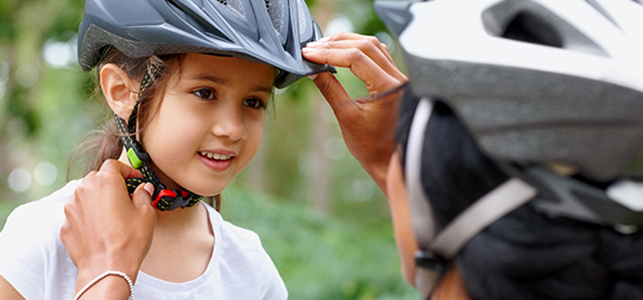
More and more bikes have been dusted off and taken to the roads in the last several weeks as people are looking for socially-distanced activities outside the home. Biking and other wheeled sports – skateboarding, scooter riding and rollerblading – can make for excellent exercise and family time, but make sure to help kids brush up on some safety measures before setting off on their adventures.
“As we head into summer, it’s a great time to talk with kids about outdoor safety of all kinds, biking included,” said Corri Miller-Hobbs, registered nurse and Safe Kids Virginia program coordinator. “With schools closed, kids have had more time to learn how to ride, or gain increased independence, on their bicycles. While this is wonderful, we strongly encourage parents to take a few moments and teach kids about the importance of riding responsibly.”
A properly-fitted helmet is the best way to prevent a head injury in the event of a crash. Make sure each family member has a helmet that is the right size for them and that they wear it on every ride. Helmets should meet the U.S. Consumer Product Safety Commission’s standards.
The same helmet can safely be worn for bicycling, scooter riding or roller skating. Skateboarding and long boarding require unique head protection. If your child participates in these activities, be sure to get them a CPSC certified skateboarding helmet.
A helmet isn’t effective unless it fits and is worn properly. The Safe Kids helmet fit test uses the eyes, ears and mouth to confirm the correct position and a snug, comfortable fit.
Watch Corri Miller-Hobbs explain here
 Is each bicycle in good working order? Check that the brakes are working, tires are properly inflated, gears shift smoothly and reflectors are secure before riding.
Is each bicycle in good working order? Check that the brakes are working, tires are properly inflated, gears shift smoothly and reflectors are secure before riding.
It’s also important to ensure your child’s bike is the right size. It can be tempting to buy a bike they can grow into, but this can be dangerous. Your child’s feet should be able to touch the ground when sitting on the bicycle seat.
If you’re riding in the early morning or evening, use lights and reflectors to help drivers see you. Reflective clothing is also a great idea.
Kids should be actively supervised until you’re comfortable they are responsible enough to ride on their own. Every child is different, but developmentally, it can be hard for kids to judge speed and distance of cars until age 10, so limit riding to sidewalks, parks or bike paths until then.
When making the transition to riding on the road, review and practice the following rules:
In this case it’s not about what the clothes look like, but rather their function.
The best way to reinforce safe riding is to model it yourself. Wear a helmet (even if you didn’t when you were a kid!) and follow all safety rules on every ride.